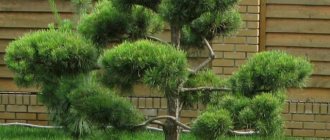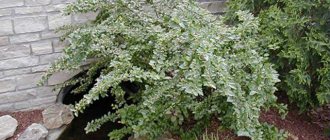Category: Landscape design of a personal plot, decorating a garden with your own hands Published 03/18/2013 · Comments: · Reading time: 3 min · Views: 231
Probably every summer resident dreams of a tree that will be the accent of the entire garden, decorative all year round. It can be a tree with a weeping form. It looks amazingly elegant and romantic and delights you with flowers in spring, a cascade of leaves in summer, bright colors of leaves and fruits in autumn, and beautiful branches in winter.
Weeping trees are especially impressive near ponds or in a Japanese garden (where a weeping willow or maple is an integral element of the garden, setting the mood). They can be a wonderful backdrop for a flower garden, form romantic alleys, or serve as a shady, cozy canopy for a bench.
Description of the plant
There are many forms of wood in nature. They come in both huge species and small shrubs. We have about 100 of them growing.
Willow is interesting for its decorative properties. It has a through and transparent crown, which reaches 25 meters. The trunk is strong with gray bark. At first, the crown of the tree has a columnar shape, which over time becomes spreading and wide. The branches are thin and very flexible. Their bark can be light, green, or purple. The shoots are directed upwards, and the side shoots hang down. Petiolate leaves are alternately located on them. The leaf shape is elliptical; some species are characterized by being long and narrow. The color of the foliage is dark green, the bottom is lighter or bluish. The flowers are inconspicuous in the form of earrings. Their flowering begins before the growth of foliage in early spring. The fruit is formed in the form of a box with small seeds, pubescent on top. They are capable of being transported by wind over long distances.
Weeping forms of trees. Pruning, crown formation
Probably every summer resident dreams of a tree that will be the accent of the entire garden, decorative all year round. It can be a tree with a weeping form. It looks amazingly elegant and romantic and delights you with flowers in spring, a cascade of leaves in summer, bright colors of leaves and fruits in autumn, and beautiful branches in winter.
Weeping trees are especially impressive near ponds or in a Japanese garden (where a weeping willow or maple is an integral element of the garden, setting the mood). They can be a wonderful backdrop for a flower garden, form romantic alleys, or serve as a shady, cozy canopy for a bench.
Growing a tree
Willow is grown in a place open on all sides, which has neutral or slightly acidic, high-humus loamy soil.
The tree does not particularly like excessive moisture. If the soil around it is too wet, the roots will slow down their development. This, of course, is reflected on the surface of the tree. Willow has enough natural precipitation, so it does not need to be watered additionally. The exception would be a prolonged drought. During these periods, watering is allowed once every 10 days. It is advisable to spray the tree crown using sprayers at the same time as watering.
In order for the tree to develop well, it is provided with proper feeding. Rotted organic matter is used. It is brought in along with digging up the tree trunk ring. It is recommended to apply a bucket of organic matter and up to 100 grams of mineral fertilizer per plant. Willow is fed in spring and autumn.
For the first four years, the willow is not touched. In subsequent years, it is recommended to prune the willow in order to shape it. If this is not done, the crown becomes sparse and not dense, causing the decorative appearance to be lost. This raises the question, how to prune willow correctly? Let's look at this using examples of the most common types of wood in our country.
What kind of weeping trees are there?
The weeping form of a tree can be formed in 2 ways: natural and artificial. The artificial crown is either formed in various ways or grafted onto a standard. Some species of willows, birches, and rowan trees have a natural “weeping” quality.
Almost all trees with flexible branches or vines are suitable for the artificial formation of weeping forms. Especially such as: goat willow, silver birch, rowan, willow pear, caragana tree (aka yellow acacia), hazel, rowan, linden, apple, larch, pine, spruce. You can even grow vines (roses, wisteria, etc.) on a trunk, creating weeping forms.
Common types of willow and their pruning
The tree tolerates pruning well. It is carried out after the plant grows about a meter. All shoots are cut to 30 centimeters. Typically, the procedure is best done in the spring. Trees that are actively growing are also pruned in the summer. And so, in the summer, only dead shoots are removed. As a result of pruning, the willow tree becomes attractive, and its bark thickens.
Most often, the following species are grown in our parks and require special formative pruning:
- White willow. Frost-resistant powerful species with a shapeless crown. It is formed by straight branches, with extending drooping shoots. The tree forms a crown on its own, but due to uneven growth it can break, so it is formed in the early stages. Pruning helps distribute branches evenly. For this purpose, a young tree is cut into a stump so that pronounced shoots are formed.
The tree is formed as a standard tree. The main trunk is left and all buds that form below two meters are removed. The excess ones located above are removed evenly. Once you have the tree's skeleton properly formed, minor pruning will be needed later.
To grow a tree with spectacularly colored shoots, you need to prune it every year into a stump, or into a standard. Its height will vary from half a meter to one and a half meters, it all depends on the desired effect.
The shape and height of pruning are established in the early stages, since adult specimens react poorly to large wounds, because these places are subject to infection with rot, and hollows form there.
If it is necessary to remove dangerously located large branches from a tree, then the procedure should be performed by a professional; if a similar situation occurs again, it is better to cut off the old tree and plant young trees. White willow is considered the largest species
- Goat willow. Frost-resistant tree with an umbrella-shaped crown. This species is compact and slow growing. In the spring, it forms many male earrings. Mostly weeping standard trees are sold. They are a cultivated form that is grafted onto a cleaned stem. Its height is on average 1.5 meters. This species does not require pruning in order to form a crown; it is enough to simply trim it so that it does not thicken and fall to the ground.
During maintenance annual pruning, half the branches are removed, creating airy foliage. These shoots will grow to the ground at the end of the growing season. It is also necessary to thin out the branches in the middle of the crown, so that an end-to-end canopy in the form of an umbrella is formed. Next, the side shoots that are located from the outside are removed. The remaining branches are shortened to half the size. In the spring, when active growth of shoots begins, all traces of pruning will be disguised. All buds that appear in areas below the graft must be removed.
- Mourning willow. This is a conical frost-resistant type. It is a hybrid of white willow and Babylonian willow. Interesting with bright green foliage and yellow shoots.
In young animals, they try to form a strong trunk with horizontally located branches. They can withstand a stem height of 1.5 to 2 meters. As the willow grows, the central shoot is shortened so that the crown expands and acquires a weeping appearance. Over the years, the tree grows in height due to individual shoots directed upward, but they gradually begin to droop over the course of the year. They should not be removed, since direct growth is a temporary phenomenon. Every year a new shoot will appear, which is why the crown gradually becomes cascading. When the tree is fully formed, there will be little pruning. It is necessary to thin them out so that light and air can get inside the plant. This strengthens the side branches, their weight gradually increases as the crown grows in width. Deep pruning does not work well on willow.
How to properly form a willow tree on a trunk
Goat willow on the Pendula trunk has recently become extremely popular in gardens. Gardeners like the unusual shape of the plant, its decorative appearance, the ability to shape the tree at their own discretion, as well as its compactness.
In order for a willow on a trunk to maintain its height and shape for a long time, it must be trimmed correctly. Otherwise, the branches will not grow at all the way you want, they will lie down in a shapeless mass on the ground, and the willow will lose its decorative effect. Correcting the shape of the tree in the future will not be easy.
I’ll tell you about my experience of forming Pendula willow on a trunk. At the end of the article, I’ll share how to add some flair to your willow tree.











